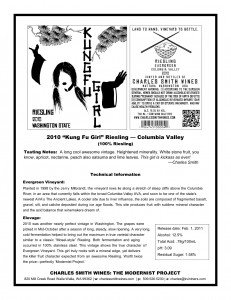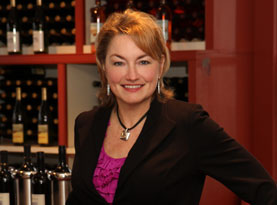Pairing Barcodes and Wine
QR codes (Quick Response Codes), like their older cousin the bar code, are becoming an increasingly common part of modern life. One creative use of the ubiquitous boxes full or squiggly lines is by restaurants that use them in restrooms to remind patrons to flush or wash their hands. The estate of Abbott and Costello is now selling t-shirts with QR codes that have scanning capabilities to play the famous ‘Who’s on First” bit from a 1930’s radio show on a cell phone.
A number of wine producers in the Midwest have begun or plan to begin using QR codes in wine marketing applications. Dick Faltz, founder of Fox Valley Winery in Oswego, Ill., says his 25,000-gallon year operation is studying how to best use QR codes.
According to Faltz, one application is to put smartphone QR codes on labels that direct consumers to the winery’s website. ‘There are so many things you can incorporate on a QR code that the consumer would really appreciate the information,” Faltz says. ‘The QR Code is a salesman in a box, or cube if your will.”
A winery already using QR codes on wine labels is Charles Smith Wines in Walla Walla Wash. Lynne Anderson, Marketing Director at Charles Smith Wines, says the winery began using QR codes on their wines, including Kung Fu Girl 2010 Washington State Riesling, starting with the most recent vintages that came out at the end of 2010 and this year.
To continue reading this post, you must either subscribe or login.[login_form][show_to accesslevel=”annual-membership” ]

Scanning the QR Code on the bottle brings consumers to a technical information page. Click on the picture to see more detail.
During July, Charles Smith will start linking their QR codes to a website that will feature video tasting notes and a video interview with the winemaker, Charles Smith. The total case production for Charles Smith is in the ‘six figures” and they sell in all 50 states and 11 foreign countries.
Anderson said that if a wine buyer is presented with a choice between two wines, one with an in depth description by simply scanning the bottle with a smart phone, the purchase decision would be tilted in favor of the wine with the QR code.
Creating a sense of user friendliness allows QR codes to also be used to enhance and expand written marketing materials. The Great River Road Wine Trail, which consists of 10 wineries near the Mississippi River in Minnesota, Wisconsin and Iowa, placed QR codes on Wine Trail brochures for the first time in 2011. According to Marvin Seppanen, co-owner of Garvin Heights Vineyards in Winona, Minn., a Wine Trail member, the QR code on the brochure directs consumers to a Google maps application with all of the Wine Trail member’s locations clearly marked.
QR Code History and Confidentiality Issues
Quick Response Code is a registered trademark of Denso Wave, Inc., but is an open standard, which means it’s publicly available to any developer according to Kevin Bradshaw, business development and sales manager at Denso Sales California, Inc. in Long Beach, Calif. The codes were first developed in Japan in 1994 to track the production of Toyota automobile parts, then were adapted for other uses including retail packaging and are frequently used throughout Europe and Asia.
Denso Wave sells software to create QR Codes and scanners to read them, he said. While there are many websites that create QR Codes for free, there are potential problems with them Bradshaw warns.
First, Bradshaw said he has seen QR Codes that were not created to standard, and were therefore more difficult, or impossible, to scan properly. Second, Bradshaw said the websites that offer free QR codes often track what smart phone users do without the phone users consent.
When QR Codes are scanned, a considerable amount of data can be gathered, including what phone scanned the code, where it was scanned and what the user clicked on while at the website, Bradshaw said. Because that information can be recorded, Bradshaw said it is an important to give users an opt-in option before sending them to the designated website. (Lynne Anderson at Charles Smith Wines said they do not collect information about who scans their wine bottles and have no intention of doing so.)
Bar Codes
Bar codes may not have the same cutting-edge appeal of QR codes, but many wineries have incorporated bar codes into their operations throughout many years.
Joe Zuiderveen, vice president of sales at St. Julian Winery in Paw Paw, Mich., which has production capacity of 1.5 million gallons per year, says that bar codes allow St. Julian to purchase market research data from national firms like Nielson and Symphony IRI Group. St. Julian is distributed throughout the Midwest and on the East Coast. Zuiderveen said bar code sales data is essential to determine how different products performed in various markets.
The marketing research that can be extracted from bar code scans at cash registers help Zuiderveen see developing trends at the retail level. ‘If we see a trend evolving or a price category evolving, we can get involved in that,” Zuiderveen said. ‘You look at the competition and see where they’re getting their growth from.”
Not all Midwest wine producers label bottles with UPC barcodes. David Danzinger, general manager and co-owner at Danzinger Vineyards in Alma, Wisconsin, said they produce 30,000 bottles per year at their estate winery. He said they might consider adding UPC barcodes to product labels when they reach 40,000 bottles a year.
For wineries interested in incorporating UPC barcodes, there is more than one source available.
Jon Mellor, director of external communications at GS1 US based in Lawrenceville, N.J., said there are no laws that enforce or regulate the use of UPC barcodes. GS1 US is a nonprofit global barcode standard organization that provides the first set of numbers in UPC barcodes, called business prefixes, to member organizations. The organization develops the standards for UPC barcodes and makes sure there are no duplicates.
Mellor said there are companies that purchase UPC barcodes and resell them to other organizations. Mellor said he does not recommend that practice because of traceability reasons.
‘If there’s a product recall, or if for some other reason somebody wants to trace [a product] back to its original source, they’re going to come to me; they’re not going to come to you,” Mellor said. ‘You want to have your own, authentic barcode on there.”
Barcodes in Production
Production is another area in which utilizing barcode systems can be beneficial to business.
Nancie Oxley, head winemaker at St. Julian Winery, said they label barrel heads with barcodes with information about the type of oak, the cooperage, when they acquired the barrel, what type of wine was stored in it and for how long.
‘If I’m down in the cellar trying to talk to my crew about what needs to come out and what needs to stay a little bit longer, [or] if something’s in an older barrel and I want it in a new barrel, I can easily identify them,” Oxley said.
Dion Harste, president at AgCode, Inc. in Glenwood, Minn., said his company develops detailed barcode systems for field data collection. Harste said these types of barcodes can keep track of labor, equipment, materials and schedules. He said benefits of a field data system include the ability to carefully monitor budgets and the ability to cut the time it takes to identify a recall product from four hours to less than four minutes.
Most clients who utilize this barcode technology typically farm 300 acres or more, Harste said. He said the software can provide details about who grew the grapes, when they were picked, which row the grapes were picked from, how many growing degree days they were on the vine and which other grapes they were blended with.
‘I think there’s a lot of fun that can be had there,” Harste said. ‘The consumers interested in detailed information are the types of consumers that will buy higher-end wine. That’s where I think there’s a benefit, to grow that relationship with that customer.”
[/show_to][password-recovery-link text=’Lost Password? Click here for password recovery.’]



